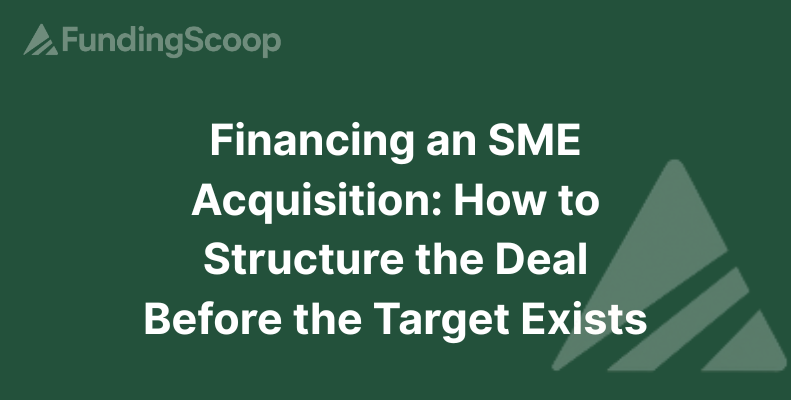
Financing an SME Acquisition: How to Structure the Deal Before the Target Exists
Marcus Ashford
TL;DR: Acquisition entrepreneurship is reshaping UK business ownership as more operators buy existing SMEs instead of starting from scratch. Success now depends on preparation, not just capital — the best buyers build lender and investor relationships early, master deal structures like earnouts and vendor finance, and align emotionally with founders. With creative funding mixes from banks, challengers, and private debt, it’s possible to acquire strong £3m-plus businesses with limited upfront capital. In 2025, the smartest entrepreneurs aren’t just founders — they’re deal architects.
For many UK entrepreneurs, acquisition is the new startup. Instead of building from scratch, the emerging wave of “acquisition entrepreneurs” are buying existing, profitable SMEs — and doing it in increasingly creative ways.
But here’s the real story: the best dealmakers don’t start by hunting for targets. They start by building their financing toolkit first.
1. Build Your Financing Bench Before You Need It
The smartest acquirers line up capital partners before they ever meet a seller. Why? Because acquisition windows are short — and sellers favour buyers who already have capital lined up.
That doesn’t mean raising a fund. It means cultivating relationships across the UK’s financing ecosystem:
- High street banks (Lloyds Bank, NatWest, Barclays) for traditional term loans or asset-backed lending.
- Challenger banks (e.g., OakNorth, Shawbrook, or ThinCats) that specialise in acquisition finance for SMEs.
- Private debt providers and alternative finance platforms that can bridge gaps with mezzanine or cash-flow lending.
- And, increasingly, private investors and search funds who are backing operators instead of startups.
Even in a high-rate environment, UK lenders remain surprisingly acquisitive — especially for deals under £5 million EV with solid EBITDA.
2. Think Structurally, Not Just Financially
A good deal isn’t just about price — it’s about structure. Here’s the insider playbook that the mid-market PE world has been using for decades, now trickling down into SME transactions:
- Earnouts: Defer part of the purchase price, linking it to post-acquisition performance. It reduces upfront cash needs and keeps the seller emotionally (and operationally) invested. (HMRC earnout guidance)
- Vendor financing: The seller acts as your lender, taking a note payable over time. This can be 10–30% of the deal.
- Equity rollovers: Allow the seller to keep a minority stake — aligning incentives while lowering your cash requirement.
- Asset-based lending: Secure debt against physical assets or receivables rather than relying solely on EBITDA multiples. (UK Finance Business Finance Guide)
The right mix of these mechanisms can make a £3 million business acquisition feasible with less than £500,000 of your own capital.
3. Reverse Engineer the Deal
Before you even pick a target, define your acquisition thesis. Are you buying growth, cash flow, or consolidation? Each one drives a completely different funding profile.
For example:
- If you’re consolidating (say, in managed IT or facilities services), lenders will love recurring revenue and contracts.
- If you’re buying for growth, equity partners may be more relevant — they’ll accept higher risk for higher potential upside.
- If you’re chasing distressed assets, cash on hand and speed matter more than structure.
Once your thesis is clear, you can start pre-qualifying with lenders — getting term sheets in principle that make you acquisition-ready. (British Business Bank: How to Finance a Business Acquisition)
4. Don’t Underestimate the Soft Side
Most SME acquisitions fall apart not for financial reasons, but emotional ones. The seller is often a founder who built the business over decades. Deals close when trust, continuity, and vision align.
A flexible structure — one that lets the seller stay on for six months, keeps their name on the door, or protects staff — can be more valuable than another turn of EBITDA.
5. The New Playbook: Entrepreneur as Deal Architect
The most interesting trend in UK SME finance right now isn’t just how deals are funded — it’s who’s doing them. Operators, not financiers, are leading the next wave. Ex-corporate managers, tech founders, and even senior employees are using acquisition finance to buy into independence.
In other words: the future of UK entrepreneurship might look less like starting the next Revolut — and more like buying the next reliable regional logistics firm.
Final Thought
In SME acquisition finance, preparation is the new leverage. You don’t need a billion-pound fund to play this game — you just need to understand the capital stack, line up your relationships early, and structure creatively.
Because when the right business comes along, the dealmakers who’ve already done their homework will be the ones signing the purchase agreement — while everyone else is still writing their funding deck.


